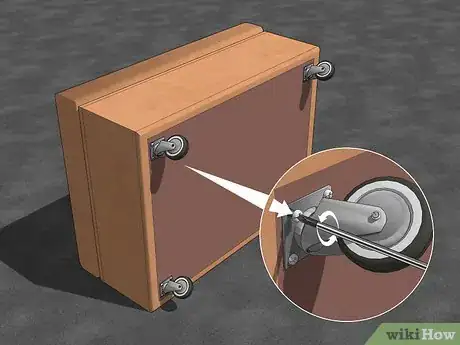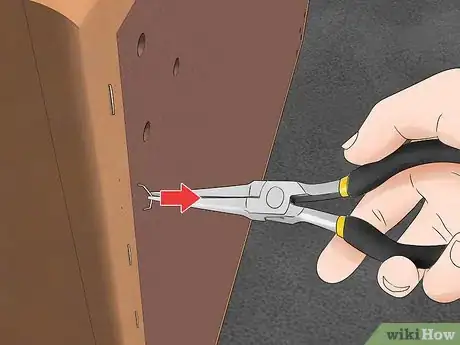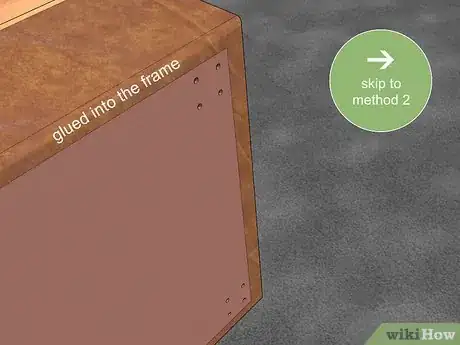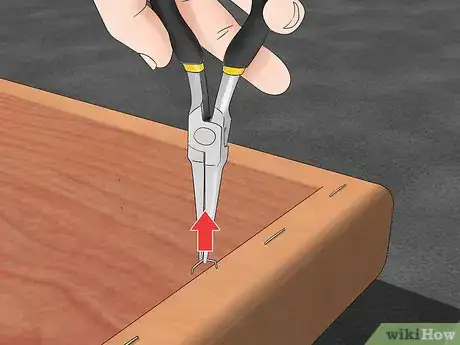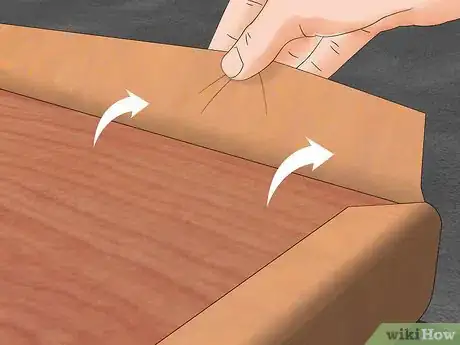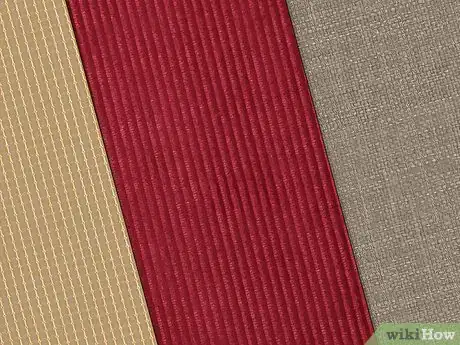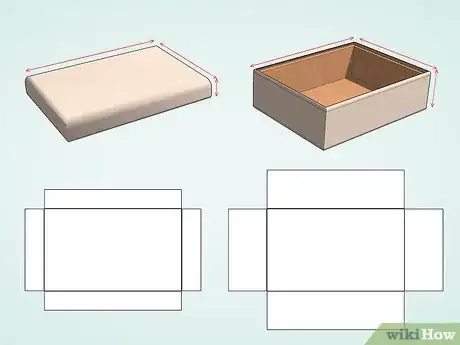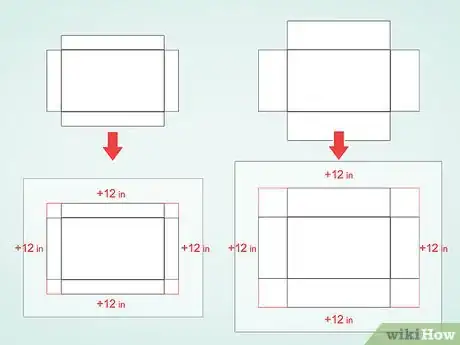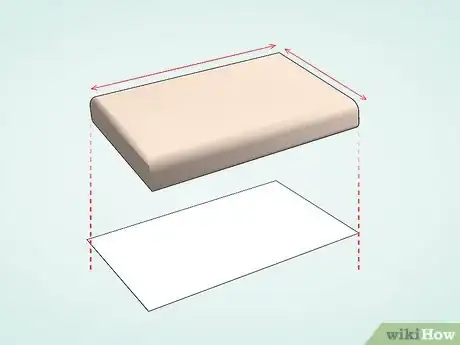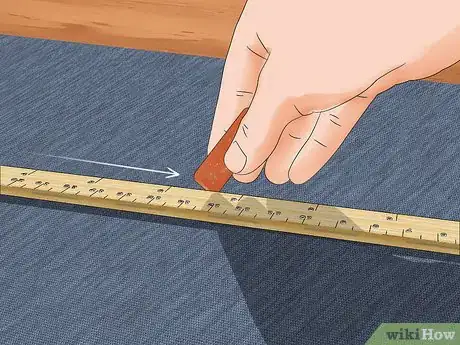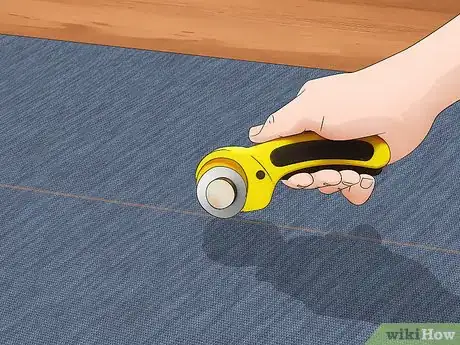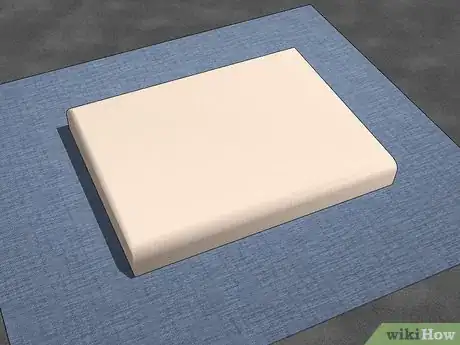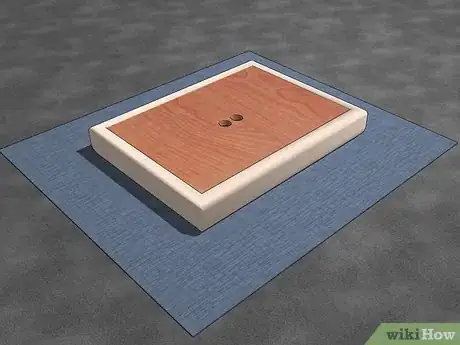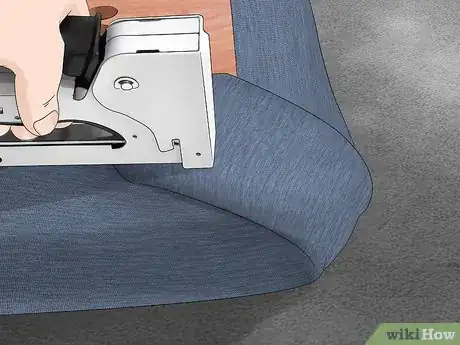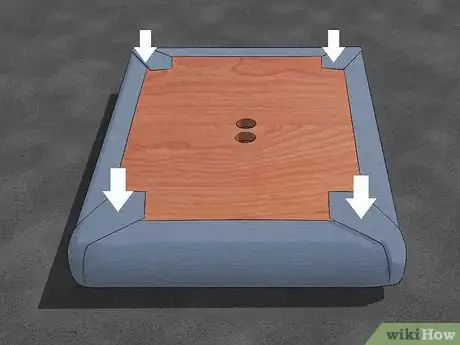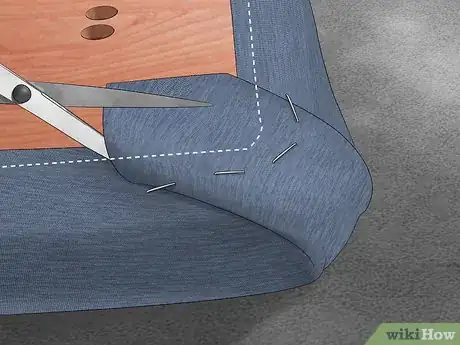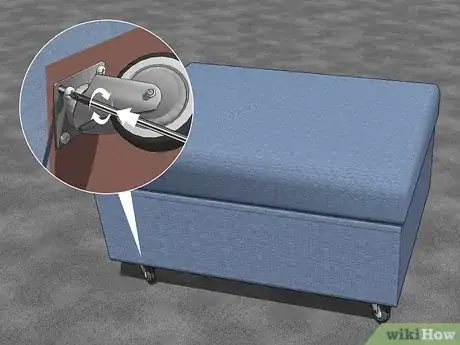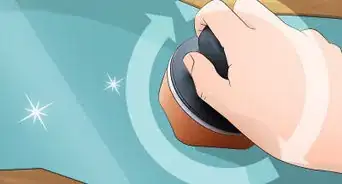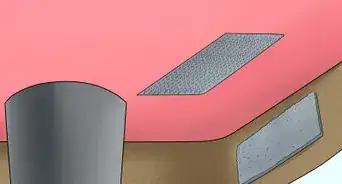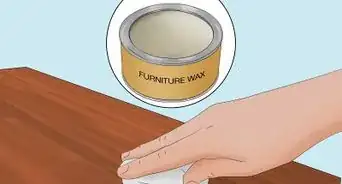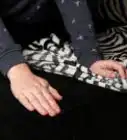This article was co-authored by wikiHow staff writer, Eric McClure. Eric McClure is an editing fellow at wikiHow where he has been editing, researching, and creating content since 2019. A former educator and poet, his work has appeared in Carcinogenic Poetry, Shot Glass Journal, Prairie Margins, and The Rusty Nail. His digital chapbook, The Internet, was also published in TL;DR Magazine. He was the winner of the Paul Carroll award for outstanding achievement in creative writing in 2014, and he was a featured reader at the Poetry Foundation’s Open Door Reading Series in 2015. Eric holds a BA in English from the University of Illinois at Chicago, and an MEd in secondary education from DePaul University.
There are 10 references cited in this article, which can be found at the bottom of the page.
This article has been viewed 10,203 times.
Learn more...
You don’t need to be a master seamstress to recover an ottoman. In fact, you can use a single sheet of fabric and some staples to fold a new cover over the padding after you remove the old one! This simple method will save you a ton of money at the furniture store and only requires some basic tools, a staple gun, some fabric, and a rotary cutter. Remember to save the pegs or wheels when you’re disassembling your ottoman so that you can use them later when you’ve recovered it.
Steps
Removing the Old Cover
-
1Flip the ottoman on its side and unscrew the legs or wheels. If your ottoman is elevated off of the ground by pegs or wheels, start by removing them. Some ottomans will have wheels or pegs that slide directly out, so try pulling a peg or wheel out first to see if it budges. Unscrew the brackets attaching any wheels with a screwdriver. Unscrew pegs by twisting them counterclockwise. Set these pieces aside to reinstall them later.[1]
- You may have to apply some firm pressure to the pegs to get them to turn. Don’t worry about breaking them since you can always install new pegs later or let the ottoman sit directly on the floor if you break them off.
-
2Rip the bottom fabric cover off or pry out the staples. Depending on the style of your ottoman, there is probably a fabric sheet stapled underneath the frame to cover the hollow center. If you don’t plan on keeping this cover, you can simply rip it off by cutting the center with a utility knife and tearing the edges off. If you do want to keep it, use the sharp point on a painter’s tool, a staple remover, or pliers to pry out the staples affixing the fabric to the frame.[2]
- Some ottomans use Velcro to keep this fabric attached. Simply pull the cover off if this is the case.
- If you keep the cover, you can re-staple it into the frame later. If you don’t, you can always make a new cover.
Advertisement -
3Leave the fabric alone if it’s stuffed-leather or glued into the frame. After removing the bottom, inspect the edge of the fabric in the base of the frame. If it isn’t stapled in and doesn’t fold up where it meets the wood, it is probably glued into the frame. If this is the case, or your ottoman is stuffed-leather, you probably cannot remove the fabric without destroying the frame or padding. You can skip the remaining steps and start measuring your new fabric.[3]
Tip: If you put new fabric on top of your old ottoman, you’re not technically recovering it; you’re simply making a case. This doesn’t mean it won’t be elegant though!
-
4Flip the hollow side up and use a drill or screwdriver to disconnect the top. Many ottomans are one solid piece, but if your ottoman has a pleat in the middle, it is probably 2 separate pieces screwed together. Look inside the hollow opening at the bottom of your ottoman and inspect the section corresponding to the pleat on the outside. If there is a 2x4 or supporting frame with screws, use a drill or screwdriver to remove the screws and take the frame out.[4]
- This will turn your ottoman into 2 different pieces to make it easier to remove and replace the fabric. Perform each corresponding step twice. Once for the top section and once for the bottom.
- If you do this and your ottoman doesn’t come apart, the fabric is probably stapled into the frame at the junction where the 2 pieces meet.
-
5Separate the fabric from the frame by prying the staples or cutting the fabric. If there are staples used to attach the ottoman’s fabric to the furniture, use the sharp point on a painter’s tool to pry the staples out. If the fabric is stitched into the bottom, use a utility knife to cut through the fabric around the entire outside of the stitching.[5]
- If you cut around the stitching, you’re going to be carving into the frame a little bit. This shouldn’t harm the structural integrity of your ottoman though, and any marks that you make will be covered by the time that you’re done.
- You can use wire cutters, a flathead screwdriver, or pliers instead of a painter’s tool to remove the staples if you prefer. It really depends on how strong and big the staples are when it comes to finding the right tool to remove them.
- Some ottomans will use both staples and stitching.
- Repeat this process on the second half of your ottoman if you separated it into 2 pieces.
-
6Remove the fabric cover by hand by peeling it off. Brace the frame of the ottoman with your nondominant hand and peel the rest of the fabric off by pulling on it with your other hand. If there are any staples remaining elsewhere on the fabric, use a flathead screwdriver to pry the fabric away from the ottoman. Stick the screwdriver’s head between the fabric and a stapled section. Push the handle away from the ottoman to pry the stapled section off.[6]
- Be careful and do this slowly. You could damage the padding if you rip the fabric off too quickly and you don’t want to cut your hand on a staple.
Choosing and Cutting the New Fabric
-
1Select a thick fabric that can be easily cut and buy some wide sheets. Cotton blends and synthetic fabrics, like acrylic, will be easier to work with than silk or linen. Choose a thicker fabric that won’t rip easily when you fold it. Choose darker colors to make it easier to hide mistakes or structures underneath. Buy rolls of fabric that are at least 4 times the length of your ottoman in any direction.[7]
- You can buy fabric rolls from a knitting or craft store. You can also order custom sheets online if you want precut fabric.
-
2Measure the length of the top and sides of your ottoman. Use a measuring tape to determine the length and width of the top of your ottoman. Draw and label this portion on a piece of paper. Then, measure each side all the way to the base. Add these labels to your drawing by illustrating the 4 sides as separate boxes that share a side with your center box.[8]
- If you have a circular ottoman, measure from one portion of the base to the base on the opposite side. Do this on the adjacent side to determine how big of a square you will need to cover the ottoman.
- You will use 2 sheets if you separated your ottoman into 2 parts.
- Alternatively, you can use the fabric pieces that you pulled off as a template. Just add 6 inches (15 cm) to each side to give you enough room to maneuver the fabric.
-
3Extend your drawing and connect the exterior lines. Your drawing should now look like a cross-shaped set of 5 boxes. Add 2 extending lines out of every exterior side until each corner meets the adjacent line and forms a 90-degree angle. Add 12 inches (30 cm) to every exterior edge.[9]
- Your drawing should now look like 9 squares inside of a larger square.
Tip: You are going to use a single sheet of fabric to cover your ottoman. To fit the corners, you will fold the fabric along the corner to make a seam.
-
4Add the measurements for the bottom cover if you’re using one. If you’re making a new bottom cover, use the measurement for the top as the measurement for the bottom cover. Add 6 inches (15 cm) on each side to ensure that you have enough room to stretch it over your base.[10]
- You are going to cut or fold the excess fabric later. It is better to have too much fabric after you’ve attached it than to have too little fabric to attach to your base.
-
5Spread your fabric out over a flat surface and mark your cuts. Spread your sheet of fabric out across the floor or a flat table. Place it upside-down and use a fabric marker to mark each cut that you need to make. Only mark the 4 exterior edges from your drawing.[11]
- You can do this in 3 pieces if you know how to sew. If you do this, use 1 piece for the top and then 2 sides per section of fabric. You can sew the 2 corners and 4 lines on the top after stapling it in place.
- You can place the ottoman’s frame upside-down in the center of the fabric if you want to make it easier to visualize where you’re going to cut.
-
6Use a rotary cutter and a cutting board to split your fabric. Place a cutting board underneath any corner. Place a ruler or second cutting board on top of the fabric and apply pressure with your nondominant hand to keep it still. Push the blade out of your rotary cutter to release it. Press it into your fabric, using the straight edge as the guide for your cut. Slide the rotary cutter along your line, moving the cutting board and straight edge further along the line after each section that you cut.[12]
- Don’t forget to cut your bottom cover out if you aren’t using the old one. If you’re cutting out a new cover, leave an extra 6–8 inches (15–20 cm) on each side.
-
7Check to make sure that the fabric will fit. Before you start stapling or folding anything, pull each side up to your base and use binder clips to keep it in place along the frame. This will also help you picture what the final product should look like.[13]
- Set your excess fabric aside. You may need to cover a section if it tears.
Installing Your New Cover
-
1Place your fabric face down and flip the ottoman over. Find a clean section of your floor or put the fabric upside-down on a large table. Spread the fabric out so that it is flat as possible to avoid any bumps or wrinkles. Place the ottoman upside-down in the center of your fabric. Stapling the new cover in while looking at the bottom will not only make it easier to see where you’re stapling, but will keep the fabric centered on the top of the ottoman.[14]
- Fold each side up to the frame to ensure that you’ve place the ottoman correctly in the center. If you haven’t, lift the ottoman up and move it before checking again. Continue to do this until your 4 sides are centered.
- If you’re covering a round ottoman, simply check to make sure that you have enough fabric on each side to reach the bottom of your frame.
-
2Staple the middle sections of each side into the bottom of your frame. Pull the fabric on one side up and put 1 staple through the center into the frame once it is flush on the side. Repeat this for each side. Then, start in the middle of one of your sides to ensure that your fabric doesn’t slide to either side as you’re stapling. Place 1 staple every 1–2 inches (2.5–5.1 cm) until you reach the last 3–5 inches (7.6–12.7 cm) near the corner.[15]
- If you have a circular ottoman, choose 3-5 6 in (15 cm) sections to leave unstapled.
Tip: Leave at least 3 inches (7.6 cm) of fabric at each corner unstapled. This will give you enough room to fold the corners back and make them flush with the edge of the frame.
-
3Fold the seam along the corner by pulling the fabric tight towards the center. Pull the unstapled corner of your fabric up so that it matches the corner of your frame. Pull the corner inwards towards the center of the ottoman while sliding the excess fabric on either side underneath it. Once the fabric is folded on top of itself, hold it still by applying pressure to the top with your nondominant hand.[16]
- If your ottoman is round, fold only one side of the fabric underneath itself. Fold the fabric in the same direction for every seam that you make.
-
4Punch 3-4 staples through your fabric into the frame. Keep the corner braced with your nondominant hand and pick up your staple gun in your dominant hand. Use your staple gun to shoot 3-4 staples into the frame. Spread your staples out along the folded corner so that every folded side has at least 1 staple attaching it to the frame.
- Leave at least 3–4 inches (7.6–10.2 cm) between your nondominant hand and the staple gun to keep your other hand safe.
-
5Repeat this process for every corner of your ottoman. If you have 2 sections, you’ll need to do this a total of 8 times, since each piece will have 4 corners. With each fold, check the seam along the frame’s side to ensure that it is folding in the same direction every time. If it isn’t, simply re-fold your corner so that the seam folds in the other direction.
- If you separated your ottoman into 2 pieces, you can either keep the fabric in the middle of your bottom piece, or cut along the edges of your frame with your utility knife to remove it.
-
6Cut the excess fabric or fold it over itself. You can fold the fabric over itself 2-3 times to flatten it, or simply cut it off with sewing scissors. If you fold it, pull the excess fabric up and fold the fabric to the left or the right down against the opposite side by sliding your other hand over it as you fold. Use 2-3 staples to secure the additional folds to the fabric.
- Use the same folding direction and style of fold for every corner.
-
7Staple your bottom cover into the base of your fabric. Place your rectangular or circular cover over the center opening. Place one staple into the middle of any side and stretch the cover across the opposite side before placing a staple on the opposite side. Repeat this process while working around the frame and place a staple for every 2–3 inches (5.1–7.6 cm) of frame.
- Place your staples above or below the staples for your upholstery.
- Use sewing scissors to trim the excess fabric if you cut out a new cover for the bottom. You won’t need to trim anything if you’re using the old covers.
-
8Reinstall your wheels or pegs by screwing them back in. Use your utility knife to cut a 1 inch (2.5 cm) X-shaped slit through the fabric where your wheels or pegs belong. Either screw your peg back in by rotating it into the threading of the frame, or use a screwdriver to reinstall the brackets where they belong with the original screws.
- You may need to cut several openings if the bracket for your screws was particularly big.
- You can also opt to use the flat base of your ottoman as the bottom and choose to simply not use the pegs or the wheels.
Things You’ll Need
- Phillips head screwdriver
- Painter’s tool or wire cutters or pliers
- Utility knife
- Drill
- Rotary cutter
- Fabric
- Cutting board
- Sewing scissors
- Staple gun
- Staples
References
- ↑ https://youtu.be/zyeOQRXwZLI?t=41
- ↑ https://www.heytherehome.com/how-to-reupholster-an-ottoman/
- ↑ https://www.heytherehome.com/how-to-reupholster-an-ottoman/
- ↑ https://youtu.be/zyeOQRXwZLI?t=85
- ↑ https://youtu.be/zyeOQRXwZLI?t=115
- ↑ https://www.heytherehome.com/how-to-reupholster-an-ottoman/
- ↑ https://youtu.be/uJE2aIpITc8?t=31
- ↑ https://myfixituplife.com/DIY/recover-an-ottoman-diy/
- ↑ https://myfixituplife.com/DIY/recover-an-ottoman-diy/
- ↑ https://myfixituplife.com/DIY/recover-an-ottoman-diy/
- ↑ https://myfixituplife.com/DIY/recover-an-ottoman-diy/
- ↑ https://youtu.be/zyeOQRXwZLI?t=502
- ↑ https://myfixituplife.com/DIY/recover-an-ottoman-diy/
- ↑ https://youtu.be/zyeOQRXwZLI?t=329
- ↑ https://youtu.be/zyeOQRXwZLI?t=380
- ↑ https://youtu.be/zyeOQRXwZLI?t=403
